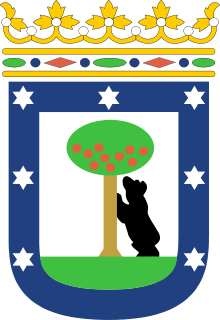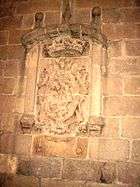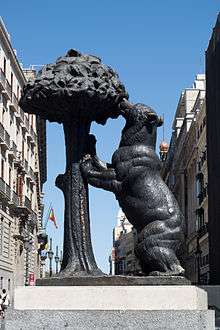Coat of arms of Madrid

The Coat of arms of Madrid, the capital of Spain, has its origin in the Middle Ages,[1] but was redesigned in 1967. In 2004 a logo it includes a shield similar to the symbol of the city and its council.
The shield is argent, a bear sable supported on a strawberry tree vert fructed gules; on a bordure azure seven stars argent. The shield is adorned with a large open royal crown of gold and precious stones, with eight rosettes (five visible) alternating with eight pearls; this crown is commonly used in Spanish heraldry for territorial and municipal arms.[2]
The image of the bear and the strawberry tree is also a component of the badge of the football club Atlético Madrid.
History
At the Battle of Las Navas de Tolosa in 1212 between Alfonso VIII of Castile and the Almohads, the council of Madrid sent a detachment in support of the Christian king. According to chronicles of the time, these troops carried a flag or banner which identified them: a statant bear on a silver field. This is the first mention in history of the shield of Madrid.
In 1222, the clergymen of the Madrilenian parishes confronted the Council for the use of the fodder in the fields and forests in the municipal jurisdiction. Those were important resources for both institutions, and both wanted the use of these lands. King Alfonso VIII determined that the fodder would belong to the clergymen, whereas the forests would pertain to the Council. This decision did not convince the clergymen, but satisfied the Council. In fact, the council was so satisfied, that it immediately modified the shield of the municipality, adding a tree as proof of its new possessions. The bear, which formerly had been displayed walking, now stood on its hind legs to eat fruits from the tree.[3] It is not certain when it was begun to consider that tree as a strawberry tree because there were few specimens of this tree species in Madrid in 1212.[4]
| History of the coat of arms of Madrid | |||
| Coat of arms | Shield | Dates | Details |
|---|---|---|---|
.svg.png) |
c.1212-1222 | In 1212, the Council of Madrid used an ensign that shown a bear with the seven stars of the Ursa Major or Ursa Minor. This flag was used in the Battle of Las Navas de Tolosa by madrilian troops.[5][6]
A later and widely spread representation of the arms of Madrid depicts two mistakes: a shield with a shape used since the 16th century and five-pointed stars Argent (white or light grey), instead of eight pointed commonly used by the Madrid Council at that time.[7] | |
.svg.png) |
1222-1544 | The bear, which had been displayed pascuant (grazing), now stood on its hind legs, rampant, to eat fruits from a tree and the seven eight-pointed stars where shown on a bordure Azure (blue).[6] | |
.svg.png) |
1544-c.1600 | In 1544 Charles I granted to Madrid the titles of "Imperial" and "Crowned" for this reason, a crown was added on the shield above the tree.[6] | |
.svg.png) |
.svg.png) |
c.1600-c.1650 | In the 17th Century the open Spanish royal crown set upon the shield.[6] |
.svg.png) |
.svg.png) |
c.1650-1859 | Circa 1650 stars set 2, 2, 2 and 1 changing to 3, 2 and 2. Consoles became a common external ornament.[6] |
.svg.png) |
.svg.png) |
1859-1873 / 1874-1931 | In 1859 were added a griffin rampant Or (golden) and a civic crown, awarded by the Cortes for the heroism of the people of Madrid against the French occupation in 1808.
The griffin has its origin in a dragon, or a serpent according to Mesonero Romanos, that was shown on the keystone in the arch of a gate of the disappeared walls of Madrid known as "Puerta Cerrada" or "Puerta de la Sierpe" (Closed Gate or Serpent Gate in English).[8] In 1582 a fire destroyed the gate. At that time the walls had fell into disuse, for this reason the gate and the surrounding wall have never been rebuilt. The serpent, become dragon, was retained as informal symbol of Madrid until the 19th century, when it was decided to incorporate the dragon that very soon turned into a griffin.[9] Eight-pointed stars were replaced by five-pointed stars and the open royal crown was changed by the Spanish royal crown closed with eight arches. Consoles, laurel wreaths and the collar of the Order of the Golden Fleece were common ornaments.[6][10] |
.svg.png) |
.svg.png) |
1873-1874 / 1931-1939 | During the First and Second Republics, the royal crown was replaced by a mural crown and the collar of the dynastic Order of the Golden Fleece was removed.[6][10]
In March 1938, following the Battle of Cape Palos, the biggest naval battle of the Spanish Civil War, the Distintivo de Madrid, which had been established by the Second Spanish Republic in order to reward courage,[11] was given to Spanish Republican Navy cruisers Libertad and Méndez Núñez, and destroyers Lepanto, Almirante Antequera and Sánchez Barcáiztegui, as well as to their crew members. These ships would thenceforward fly a special pennant and the men would wear a special badge on their uniforms with the coat of arms of Madrid.[12] |
.svg.png) |
.svg.png) |
1939-1967 | In the Francoist period, the five-pointed stars became six-pointed stars and the mural crown was replaced by the heraldic open crown used by Franco's regime. Consoles and laurel wreaths became unusual.[10][13] |
.svg.png) |
.svg.png) |
1967-1982 | In 1967 the griffin and the civic crown were removed.[14] |
 |
 |
1982–Present | In 1982 the heraldic open crown used by Franco's regime was replaced by the older open royal crown. The design of the elements has become more simplified and the escutcheon shape has been changed too.[15] |
Gallery
 Coat in la Casa del Pastor, in calle de Segovia, considered as the oldest in the city |
_-_Parque_del_Retiro_-_20070805.jpg) Historic coat of arms in Alcachofa Fountain, Retiro Park |
 Distintivo de Madrid pennant awarded to the Spanish Republican Navy vessels that took part in the Battle of Cape Palos |
 Logotype used as common emblem by the City Council |
 The Statue of the Bear and the Strawberry Tree in Madrid, by Antonio Navarro Santafé |
See also
References
- ↑ Ayuntamiento de Madrid
- ↑ Dirección General de Administración Local - Consejería de Justicia y Administraciones Públicas
- ↑ El escudo de Madrid
- ↑ (Spanish) Árboles de Madrid. El Madroño. Foto Madrid.
- ↑ Álvarez y Baena, José Antonio (1786). Compendio histórico de las grandezas de la coronada villa de Madrid, corte de la Monarquía de España. Madrid: Antonio Sancha (Print.)
- 1 2 3 4 5 6 7 Gea Ortigas, María Isabel (2008). Historia del oso y el madroño : (los escudos de Madrid). Antiguos cementerios de Madrid. Madrid : La Librería, (4th ed.) ISBN 978-84-89411-35-7.
- ↑ Image of the first version of the arms of Madrid representation.
- ↑ Ramón Mesonero Romanos, (1861), El antiguo Madrid. Madrid, F. de P. Mellado Print. P. 90.
- ↑ (Spanish) Ocno Bianor y el dragón de la Puerta Cerrada, Madrid Diario(2009-03-29).
- 1 2 3 "Título preliminar, 1948 Madrid City Council Regulation" (PDF). www.madrid.es (in Spanish). Madrid City Council. Retrieved November 3, 2013.
- ↑ Second Spanish Republic 23 January 1938 Decree
- ↑ Enrique García Domingo, Recompensas republicanas por el hundimiento del Baleares, Revista de Historia Naval 1997, Año XV no. 59, pg. 70 Archived December 15, 2013, at the Wayback Machine.
- ↑ 1939 Coat of ams image.
- ↑ 1967 Coat of ams image, Sitographics.com.
- ↑ "Art. III, 1982 Madrid City Council Regulation". www.madrid.es (in Spanish). Madrid City Council. Retrieved November 3, 2013.
External links
| Wikimedia Commons has media related to Coats of arms of Madrid. |